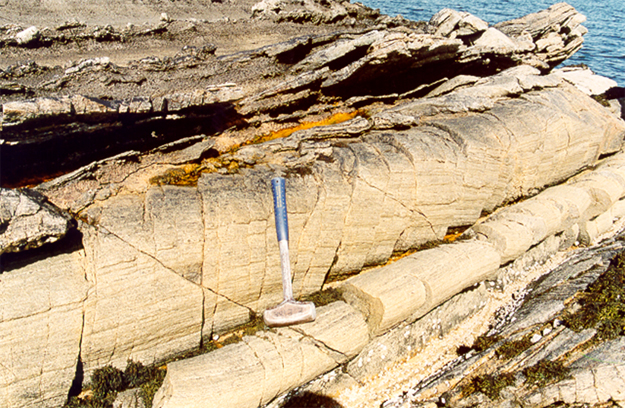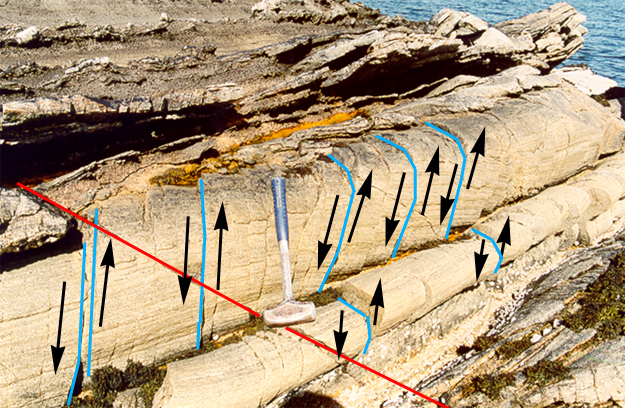Elizabeth Eide of the National Academies shared this image with me a year or two ago, when she gave a talk on Norwegian geology for the Geological Society of Washington.

Those are some bookshelfed gneiss layers sandwiched between upper-left and lower-right carbonates. The “bookshelfing” refers to the numerous parallel brittle fractures along which the gneiss slabs have slid down the face of their neighbors, like a set of encyclopedias tilted to one side. It reminds me of two baguettes side by side, sliced, with the slices drooping down and spreading out.

Those bookshelf fractures must have partially healed, for they were cross-cut by a later joint set (one good example is highlighted in red) which shows no offset on either side of the blue-highlighted bookshelf fractures.
Elizabeth included the following description of the geology of the region when she first sent me the photo for use in my Structural Geology course at GMU. She graciously allowed me to republish her photo here on the blog:
At the top and bottom of the photo are metasediments—carbonates, primarily, as you can see from the way they’ve been eroded. The bookshelf-type feature overprints the mullion texture in what my notes say (and my notes are a better record than my eyes on the picture nearly a decade later) is a felsic gneiss. Common mix of metasediments and gneisses with igneous origins in the area. The orientation of the elongation (roughly flat-lying here) is NE-SW and the bookshelf features dip to the SW (top-SW). The high-grade (high pressure) metamorphism in the area is around 400-410Ma. The Ar/Ar cooling ages for the rocks in this vicinity (what is attributed to cooling and unroofing after HP-UHP metamorphism) is ca. 380-385 Ma. Not sure what age the brittle features are—probably fairly young (relatively), Mesozoic, in age, perhaps younger. The outcrop is from a skerry off the coast of western Norway.
Mullions are like boudinage, but “boudinage” is what we call it in 2D outcrops, where it looks like sausages, but in 3D, these structures extended rod-like back into the rock. These are the “baguettes” I mentioned above. I’m not sure how to best interpret this overall story – are the mullions straight-up extensional features, or are they smaller-scale structures that reveal a larger pattern, like a fold? I wonder, looking at the photo, whether I am peering into the eroded heart of an antiform, like so (mullions in white):

(I drew that on my iPad with my finger!)
The brittle bookshelfing came later, of course. How much later? I’d love to know – Somebody grant me some funds to go poking around in Norway and find out!
Cool rocks, regardless. Thanks to Elizabeth for sharing them!

Volunteering to carry samples, hold hammers, etc. Some Nordic geology sounds absolutely fine!